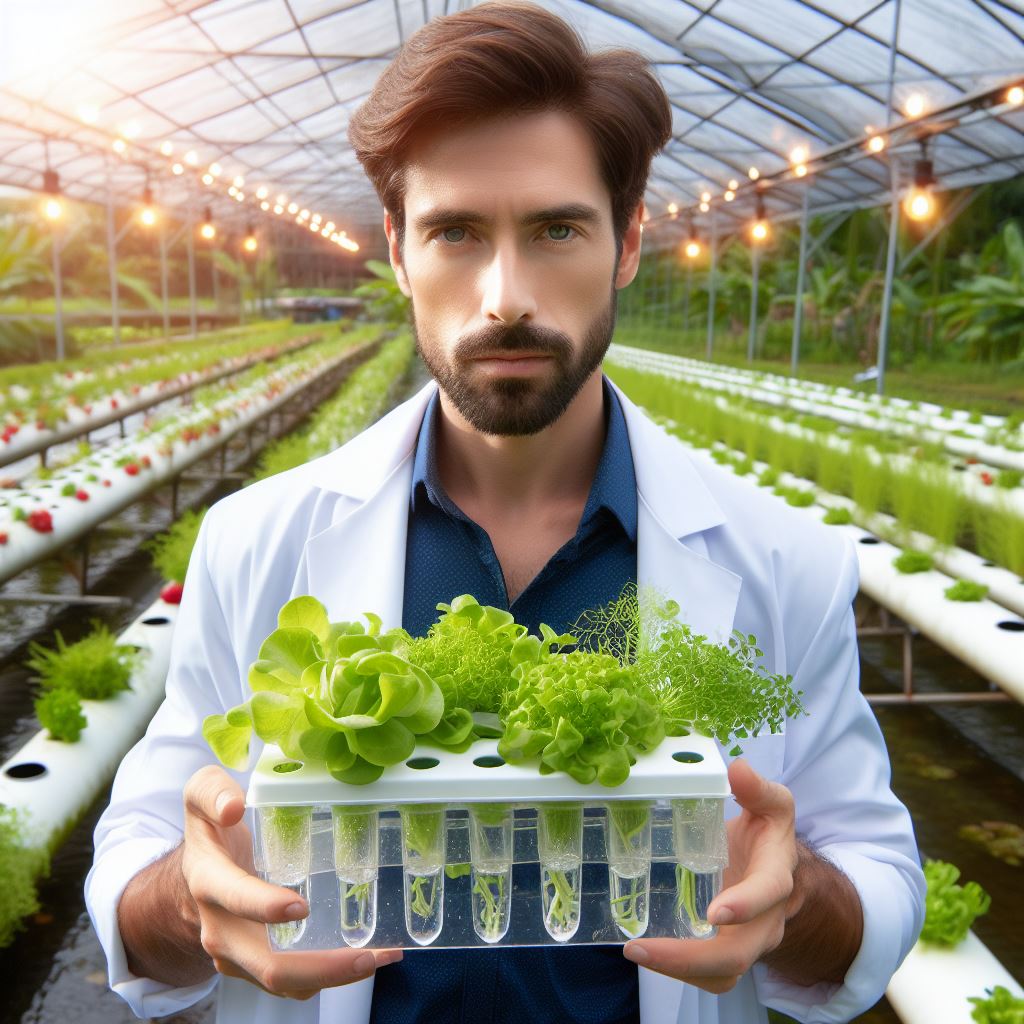Introduction
Aquaponics, a revolutionary farming method, merges aquaculture and hydroponics for sustainable food production.
This innovative system is hailed as the future of farming due to its efficient use of resources, environmental benefits, and high productivity.
Traditional agriculture faces challenges such as soil depletion, water scarcity, and chemical runoff.
Aquaponics addresses these issues by creating a symbiotic relationship between fish and plants.
Fish waste provides essential nutrients for plant growth, and in turn, plants purify the water, creating a closed-loop ecosystem.
The purpose of this blog post is to delve into the key aspects of aquaponics, exploring its environmental impact, potential for scalability, and the role it can play in ensuring global food security.
Join us on this journey to uncover the transformative potential of aquaponics in shaping the future of agriculture.
Definition and Explanation of Aquaponics
Aquaponics: Future of Farming?
Aquaponics is the fusion of aquaculture and hydroponics, creating a sustainable farming method.
In this system, fish and plants have a symbiotic relationship.
The fish provide waste that is converted into nutrients for the plants, while the plants filter the water for the fish.
This closed-loop system has numerous benefits.
Symbiotic relationship between fish and plants in an aquaponic system
Firstly, aquaponics is known for its water conservation advantages.
Unlike conventional farming, where water is wasted through evaporation or runoff, aquaponics recirculates water.
The plants absorb the water they need, and the excess is filtered back to the fish tanks, creating a continuous cycle.
This reduces overall water usage and makes aquaponics a more environmentally friendly choice.
Furthermore, aquaponics also offers organic produce. Since the system relies on natural processes, there is no need for synthetic fertilizers or pesticides.
The fish waste provides the necessary nutrients for the plants, creating a natural and nutrient-rich environment.
As a result, the produce grown in aquaponics systems is often considered organic.
This is a significant advantage for those seeking healthy and sustainable food options.
Beyond the environmental benefits, aquaponics is also advantageous for its efficiency.
The symbiotic relationship between fish and plants allows for a faster growth rate.
The plants can access the nutrients directly from the fish waste, resulting in healthier and more productive crops.
Additionally, the closed-loop system minimizes the need for laborious maintenance and reduces the risk of pests and diseases commonly found in soil-based farming.
Benefits of this system, such as water conservation and organic produce
Moreover, aquaponics is a versatile farming method.
It can be implemented in various settings, making it suitable for both urban and rural areas.
Its vertical designs and compact setups can be tailored to fit limited spaces, such as rooftops or unused buildings.
With its adaptability, aquaponics has the potential to revolutionize agriculture by bringing farming closer to urban populations and promoting local food production.
In addition to its practical advantages, aquaponics also presents educational opportunities.
It serves as an excellent teaching tool for students to learn about biology, ecosystems, and sustainable practices.
Schools and educational institutions can use aquaponics systems as a hands-on approach to teach students about food production, water conservation, and environmental stewardship.
Although aquaponics offers numerous benefits, it does come with its own challenges.
Maintaining the delicate balance between fish and plants requires careful monitoring of water quality parameters such as pH, temperature, and ammonia levels.
Additionally, the initial setup costs may be higher compared to traditional farming methods.
However, the long-term benefits of increased productivity, organic produce, and reduced water usage often outweigh the initial investment.
Basically, aquaponics is a sustainable farming method that combines aquaculture and hydroponics.
The symbiotic relationship between fish and plants creates an efficient, water-saving system that produces organic food.
Its versatility and educational potential make it a promising future for farming.
While challenges exist, the benefits of aquaponics make it a viable solution for a more sustainable and environmentally conscious agricultural industry.
Read: Farm-to-Table 101: Basics of Farm-Fresh Eating
Advantages of Aquaponics
In today’s blog section, we will be exploring the advantages of aquaponics as the future of farming.
Aquaponics is a sustainable farming method that combines aquaculture and hydroponics to create a symbiotic ecosystem where plants and fish thrive together.
- Aquaponics overcomes traditional farming limitations by providing a more efficient and sustainable way of growing food.
- One of the significant advantages of aquaponics is the use of less space and water compared to conventional agriculture.
- Unlike traditional farming, aquaponics eliminates the need for chemical fertilizers and pesticides, making it environmentally friendly.
- Aquaponics has the potential for year-round cultivation, regardless of weather conditions, allowing farmers to have a constant supply of fresh produce.
- Another advantage of aquaponics is its ability to produce higher crop yields compared to traditional farming methods.
- By recycling water in the system, aquaponics uses up to 90% less water than conventional agriculture.
- The elimination of soil in aquaponics reduces the risk of soil-borne diseases and pests, resulting in healthier plants.
- Aquaponics systems can be set up anywhere, including urban areas, rooftops, or even in unused buildings, making it accessible to all.
- With aquaponics, there is no need for constant weeding and tilling of the soil, saving farmers time and effort.
- Since aquaponics relies on natural processes, such as the nitrogen cycle, it creates a more balanced and sustainable ecosystem.
Elimination of the need for chemical fertilizers and pesticides
Aquaponics offers numerous advantages over traditional farming methods.
The use of less space and water allows farmers to maximize their production while conserving resources.
By eliminating the need for chemical fertilizers and pesticides, aquaponics promotes healthier and safer food production.
The potential for year-round cultivation ensures a constant food supply, regardless of external factors like weather conditions.
Additionally, aquaponics has proven to yield higher crop yields, contributing to efficient food production.
The water-saving aspect of aquaponics is particularly crucial in regions with water scarcity.
Conventional agriculture is notorious for its high water demand, contributing to water shortages in many areas.
In contrast, aquaponics recirculates water within the system, minimizing water wastage and reducing the strain on water resources.
Transform Your Agribusiness
Unlock your farm's potential with expert advice tailored to your needs. Get actionable steps that drive real results.
Get StartedTransforming Agriculture for a Sustainable and Efficient Future
Moreover, the absence of soil in aquaponics reduces the risk of soil-borne diseases and pests.
This eliminates the need for chemical pest control methods, resulting in healthier plants and produce.
Additionally, the controlled environment of aquaponics systems allows farmers to have better control over the growth conditions, resulting in higher-quality crops.
Aquaponics also offers versatility in terms of location.
It can be implemented in various settings, such as urban areas or unused buildings, making it an ideal solution for those with limited space.
By utilizing vertical farming techniques, aquaponics allows farmers to grow more crops in a smaller area.
The simplicity and efficiency of aquaponics systems also benefit farmers.
With no need for constant weeding or tilling of the soil, farmers can save time and effort.
This means they can focus on other important tasks, such as monitoring water quality or expanding their operations.
Overall, aquaponics has the potential to revolutionize the future of farming.
Its sustainable and efficient nature addresses many of the limitations of traditional agriculture.
By utilizing less space and water, eliminating the need for chemicals, and providing year-round cultivation, aquaponics offers a promising solution for food production in an increasingly resource-constrained world.
Read: Farm Animal Welfare Issues
Environmental Sustainability
Aquaponics is a farming method that holds great promise in terms of environmental sustainability.
It offers several advantages over traditional farming practices, making it a potential future of farming.
Reduction in Water Usage
- Aquaponics utilizes a closed-loop system, where water is recirculated between the fish tanks and the plant beds.
- This system requires only a fraction of the water used in conventional agriculture, making it highly water-efficient.
- The reduced water usage of aquaponics is crucial in regions experiencing water scarcity or drought.
Elimination of Soil Erosion and Runoff
- Aquaponics eliminates the need for soil in farming, as the plants are grown in a soilless medium.
- This eliminates soil erosion, a major environmental concern that contributes to land degradation.
- Furthermore, the absence of soil also means no runoff, which prevents the contamination of nearby water bodies with chemical fertilizers and pesticides.
Reduced Greenhouse Gas Emissions
- Traditional agriculture practices, such as industrial farming, contribute significantly to greenhouse gas emissions.
- In contrast, aquaponics has the potential to reduce these emissions.
- The closed-loop system used in aquaponics minimizes the use of synthetic fertilizers and pesticides, which are known to release greenhouse gases.
- In addition, the natural filtration process in aquaponics systems reduces the emission of methane, a potent greenhouse gas.
Aquaponics offers a sustainable farming method that addresses the environmental issues associated with traditional agriculture.
By reducing water usage, eliminating soil erosion and runoff, and minimizing greenhouse gas emissions, aquaponics presents a viable solution for a greener and more sustainable future.
Read: Local Food: A Social Movement

Challenges and Limitations
- Practitioners of aquaponics face several challenges in maintaining a successful system.
- One major challenge is the initial investment required for setting up an aquaponic system.
- Setting up a proper infrastructure, including tanks, grow beds, and pumps, can be costly.
- However, the long-term benefits and potential profits outweigh the initial investment.
- Another challenge is the need for proper monitoring and maintenance of the ecosystem.
- Aquaponics requires a balance of nutrient levels, pH, temperature, and oxygen levels.
- Regular testing and adjustments are necessary to ensure the health of the fish and plants.
The learning curve associated with managing a balanced system
- Additionally, managing a balanced system in aquaponics has a steep learning curve.
- Practitioners must learn to understand the interdependencies between fish, plants, and bacteria.
- They need to learn how to maintain the right nutrient levels and prevent the buildup of toxins.
- Failure to manage a balanced system can lead to the death of fish or stunted plant growth.
- Controlling pests and diseases in aquaponics can also be a significant challenge.
- Without the use of pesticides, practitioners must resort to natural methods to prevent infestations.
- Implementing companion planting and attracting beneficial insects can help control pests.
- Limitations of aquaponics include the inability to grow certain crops that require soil.
- Root crops like potatoes and carrots do not thrive in a system without traditional soil.
- Aquaponics is better suited for leafy greens, herbs, and fruits that grow well in water-based systems.
- Another limitation is the dependency on electricity to power pumps and aeration systems.
- In case of power outages, the entire system can be at risk of failure, leading to fish and plant loss.
- Extreme weather conditions can also pose challenges to aquaponics.
- Heatwaves or cold spells can disrupt the balance of the ecosystem and harm the fish and plants.
- However, with proper insulation and climate control measures, these challenges can be mitigated.
- Therefore, aquaponics presents challenges such as initial investment, monitoring and maintenance, and a learning curve.
- However, these challenges can be overcome with proper knowledge, experience, and dedication.
- The limitations, like the inability to grow certain crops and dependence on electricity, can be managed.
- Overall, aquaponics holds great potential for sustainable and efficient future farming.
Read: Pesticide-Free Farming Pros
Case Studies and Success Stories
Real-life examples of successful aquaponics farms or projects demonstrate the potential and effectiveness of this farming method.
These success stories not only showcase the positive impact and benefits of aquaponics but also highlight innovative techniques and unique setups that have led to their success.
Growing Underground
Located in an abandoned underground tunnel in London, Growing Underground is a prime example of an innovative aquaponics farm.
By utilizing vertical farming techniques and LED lighting, they are able to grow a variety of leafy greens and herbs all year round, regardless of weather conditions.
This setup has not only transformed a neglected space but also provided fresh and sustainable produce to local communities.
SweetWater Organics
SweetWater Organics, based in Milwaukee, Wisconsin, has successfully turned an old industrial warehouse into an urban aquaponics farm.
By combining fish cultivation and hydroponic vegetable production, they have created a closed-loop system where waste from the fish nourishes the plants, and the plants purify the water for the fish.
This sustainable approach has revitalized an abandoned building and provided fresh food to the local community.
Lufa Farms
Lufa Farms, located in Montreal, Canada, operates the world’s first commercial rooftop greenhouse.
By incorporating aquaponics into their rooftop farming system, they are able to maximize space utilization while minimizing environmental impact.
The fish waste provides nutrients to the plants, and the plants act as a natural filter for the fish tanks.
This innovative setup has significantly reduced water and energy consumption and has become a model for urban farming.
The Plant
The Plant, an urban farm and food business incubator in Chicago, has created a closed-loop system where waste from the production process is utilized to support aquaponics.
Their aquaponics farm not only produces fresh fish and vegetables but also utilizes waste heat from neighboring businesses to maintain optimal temperatures for plant growth.
This sustainable approach has not only reduced waste but has also created a supportive and self-sufficient ecosystem.
Green Spirit Farms
Green Spirit Farms in Michigan is one of the largest aquaponics operations in the United States.
They have successfully integrated aquaponics with vertical farming, allowing them to maximize production in limited space.
By employing advanced automation and nutrient management systems, they have achieved high yields while reducing labor and resource requirements.
This efficient setup has not only provided fresh and sustainable food but has also created employment opportunities in the local community.
These case studies highlight the positive impact and benefits that aquaponics farms have brought to local communities.
By utilizing innovative techniques and unique setups, these farms have transformed neglected spaces, revitalized abandoned buildings, and provided fresh and sustainable produce to their respective areas.
Aquaponics not only offers a solution for food production but also addresses environmental concerns.
By using a closed-loop system, it minimizes water consumption and reduces waste compared to traditional farming methods.
Additionally, aquaponics eliminates the need for synthetic fertilizers and pesticides, making the produce healthier and chemical-free.
Furthermore, aquaponics farms contribute to the local economy by creating job opportunities.
From farm management to maintenance and marketing, these farms require a diverse range of skills, providing employment opportunities for people in the community.
In short, the success stories and case studies of aquaponics farms highlight the vast potential and benefits of this farming method.
With innovative approaches and unique setups, aquaponics farms not only produce fresh and sustainable food but also bring economic revitalization and environmental sustainability to local communities.
The Future of Aquaponics
Aquaponics, a combination of aquaculture and hydroponics, holds great potential in transforming the agricultural industry.
Unlike traditional farming methods, aquaponics utilizes a symbiotic relationship between fish and plants to create a self-sustaining ecosystem that produces both food sources effectively.
The increasing interest and adoption of this farming method
In recent years, there has been a surge of interest and adoption of aquaponics as an alternative farming method.
This increasing popularity can be attributed to several factors:
- Sustainable Nature: Aquaponics systems require significantly less water compared to conventional farming, making them environmentally friendly.
- Higher Yields: The symbiotic relationship between fish and plants allows for higher yields, as nutrients are efficiently recycled in the system.
- Year-round Production: Aquaponics provides the possibility of year-round production regardless of the climate, enabling farmers to have a consistent income.
- Space Efficiency: These systems can be set up in small urban spaces, allowing for farming in areas where traditional agriculture is not possible.
Ongoing research and advancements in aquaponics technology
The ongoing research and advancements in aquaponics technology are further expanding the possibilities of its implementation:
- Improved Automation: Automation in aquaponics systems allows for better monitoring of water quality and nutrient levels, optimizing plant growth and fish health.
- Alternative Energy: Integration of renewable energy sources, such as solar or wind power, reduces the ecological footprint of aquaponics systems.
- Genetic Modification: Research is being conducted to develop fish and plant species that are better suited to aquaponics, maximizing productivity and resistance to diseases.
Potential for scalability and commercial viability
One of the most promising aspects of aquaponics lies in its potential for scalability and commercial viability:
- Large-Scale Production: Aquaponics can cater to both small-scale and large-scale operations, offering flexibility to meet the demands of markets.
- Local Food Production: By setting up aquaponics farms closer to urban areas, the need for long-distance transportation is reduced, ensuring fresher produce for consumers.
- Food Security: Aquaponics has the potential to provide a sustainable source of food, reducing dependence on traditional farming methods that are susceptible to climate change and other challenges.
- Commercial Profitability: As the demand for organic and locally sourced food continues to rise, aquaponics presents an opportunity for farmers to tap into this market and generate profits.
In essence, aquaponics is undeniably the future of farming.
With its sustainable nature, higher yields, and year-round production capabilities, it offers a viable solution to address the challenges faced by the agricultural industry.
Ongoing research and advancements, coupled with the potential for scalability and commercial viability, further solidify aquaponics as a transformative force in shaping the future of agriculture.
Showcase Your Farming Business
Publish your professional farming services profile on our blog for a one-time fee of $200 and reach a dedicated audience of farmers and agribusiness owners.
Publish Your ProfileConclusion
Aquaponics is a revolutionary farming method that combines aquaculture and hydroponics.
It offers numerous advantages such as increased production, water conservation, and sustainable food systems.
By utilizing fish waste as a nutrient source for plants, aquaponics eliminates the need for synthetic fertilizers and minimizes environmental impact.
Additionally, this farming technique can be implemented in both urban and rural areas, making it accessible to a wide range of communities.
The future of farming lies in aquaponics as it addresses numerous challenges faced by traditional farming methods, including land scarcity, water scarcity, and soil degradation.
It presents an innovative and promising solution to secure a sustainable and efficient food production system.
To truly understand the potential and benefits of aquaponics, readers are encouraged to delve deeper into this topic and explore how they can contribute to the advancement of this environmentally-friendly farming approach.




